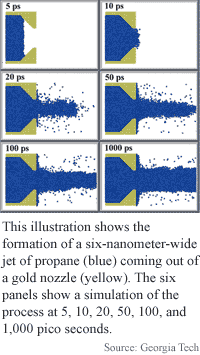
Nano-scale jets possible
By Eric Smalley, Technology Research NewsUntil recently the idea of jets as small as a few dozen molecules in diameter required a substantial leap of faith because standard fluid dynamics don't apply at such a small scale. A computer simulation that marries fluid dynamics and molecular dynamics, however, has shown researchers the light.
The simulation, developed by researchers at the Georgia Institute of Technology, modeled the interactions of 200,000 particles of propane forced at 6,000 atmospheres of pressure through a gold nozzle six nanometers in diameter. The results provide engineers with a blueprint for making nanojets.
"There's enough information now to trigger the attempt. At the moment it's a challenge to experimentalists," said Uzi Landman, regents' professor and director of Georgia Institute of Technology's Center for Computational Materials Science.
Nanojets could be an important tool in the embryonic field of nanotechnology. They could be used to build nanoscale structures or form patterns for other manufacturing techniques, said Naomi Halas, a professor of chemistry and electrical and computer engineering at Rice University.
"I see this as a very important result that could lead in numerous directions, all of which would be quite exciting to the nanoengineer," she said.
Other applications include injecting drugs directly into individual cells, and producing integrated circuits, according to Landman. "It's a way of writing things," he said. "Think about an inkjet printer. We just want to make it that much smaller. We want to go to the one-billionth-of-a-meter length scale."
The researchers modified conventional hydrodynamics models by including fluctuations in the forces that the fluids experience, Landman said. "This allowed us to take the hydrodynamics and extend it to the nanoscale."
The fluctuations allow the fluids to overcome the effects of viscosity and surface tension, which are magnified at that scale. The jets in the simulation travel 200 nanometers before breaking into droplets, said Landman.
The researchers also derived several design principles from the simulation, including the importance of heating and coating the nozzle to prevent blockages. The simulation also yielded an efficient jet design consisting of a container with a piston at one end and a nozzle that the other end that tapers at 45 degrees, Landman said.
The researchers are now working on simulating other materials, including larger organic molecules, with the idea of eventually modeling drug molecules, he said.
One of the first hurdles to overcome in producing nanojets is creating a small enough hole. "Today the smallest size is of the order of one-tenth of a micron. We want to go smaller by more than an order of magnitude," Lanman said.
Nano jets could be built in five to ten years, according to Landman. The simulation was developed by Landman and graduate student Michael Moseler. The research was funded by the Department of Energy and the Air Force Office of Scientific Research.
Timeline: >5, <10 years
Funding: Government
TRN Categories: Nanotechnology
Story Type: News
Related Elements: Graphic
Advertisements:
September 6, 2000
Page One
Nano-scale jets possible
Software squeezes 3-D data
DNA strands form nano-machine
Scaled links make nets navigable
Magnetic interface photographed

News:
Research News Roundup
Research Watch blog
Features:
View from the High Ground Q&A
How It Works
RSS Feeds:
News
Ad links:
Buy an ad link
| Advertisements:
|
 |
Ad links: Clear History
Buy an ad link
|
TRN
Newswire and Headline Feeds for Web sites
|
© Copyright Technology Research News, LLC 2000-2006. All rights reserved.